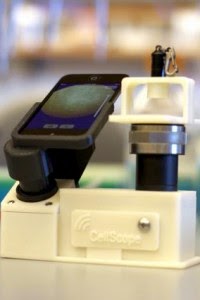| Anton van Leeuwenhoek postage stamps Netherlands 1937 (Photo credit: Wikipedia) |
 |
| Basic CellScope Image credit: www.cellscope.berkeley.edu |
This simple device can be used to detect cancerous cells in patient samples or simply identify the flora and fauna in water bodies. You could be in the middle of a sea, take a small sample of water and start recording your observations right on the deck with a CellScope. That is how quick this device is. But that is not what is really meant for!
What the inventors of CellScope want to do is make the device more smaller and portable and even simpler to use. This drive to make the device simple to use led to development of the OtoScope to help you keep a track on your child’s ear infections.
A simple addition to your phone’s camera allows a parent to tackle ear infections at their first notice. Using the Otoscope, you can easily take a video of the inner ear and send it to a doctor, at any time of the day, without having to visit a hospital. The doctor’s team at Otoscope will review the video in less than 2 hours and send you their diagnosis and even a prescription where necessary. So, no more waiting at emergencies, just because you an innovative cellscope at your disposal.
Ivermectin, an anti-parasitic drug, is a simple treatment that can be offered to patients here, but this
drug administration has been compounded by another parasite called Loa Loa, whose presence in the blood, can lead to severe brain complications, if Ivermectin is administered to the patient. Identifying whether a person is infected with Loa Loa is a completely manual task and requires a highly trained technician and a conventional laboratory microscope. In such circumstances, the government’s efforts to carry out mass campaigns to inject Ivermectin and control filariasis and onchocerciasis, are severely affected, since arranging men and machine in remote locations for mass drives for the entire country is a logistical nightmare.
 |
| “Microfilaria of L. loa in a thin blood smear, stained with Giemsa.” (Photo credit: Wikipedia) |
An advanced adaption of the CellScope was used in the pilot project, where a single drop of blood was taken from the patient and loaded onto a capillary. The capillary is then inserted into an analytical base that is paired with a smartphone. All the user needs to do is inform a custom made app that the sample has been loaded after which, the smartphone communicates with the base, moves the sample near the phone’s camera and takes a video of the blood sample. The video is then analyzed by the smartphone for a wriggling motion that is peculiar to the Loa Loa parasite and then displays the number of worms spotted in the sample. All this analysis is completed within a matter of two minutes and requires no high end microscopy or even a well trained microbiologist to tell you where the nasty Loa Loa worm is present. Patients signing up for mass administration of Ivermectin can be quickly screened and protected against any adverse side effects. Called CellScope Loa, the device works something like this.
Aren’t these guys the modern day Leeuwenhoeks?
If you would like to know more about the Otoscope, CellScope or the CellScope Loa, you can find all the information at the Cellscope site at Berkeley University. For the readers interested in knowing more about the Loa Loa Cameroon Project, the link to the research paper is given below.
And if you would like to know more about such wonderful discoveries from the world of science, subscribe to our blog and we will send you an email every time we post something new and interesting. Alternatively, you can follow us on social media such as Facebook, Twitter or Google Plus!
Reference:
D’Ambrosio MV, Bakalar M, Bennuru S, Reber C, Skandarajah A, Nilsson L, Switz N, Kamgno J, Pion S, Boussinesq M, Nutman TB, & Fletcher DA (2015). Point-of-care quantification of blood-borne filarial parasites with a mobile phone microscope. Science translational medicine, 7 (286) PMID: 25947164




